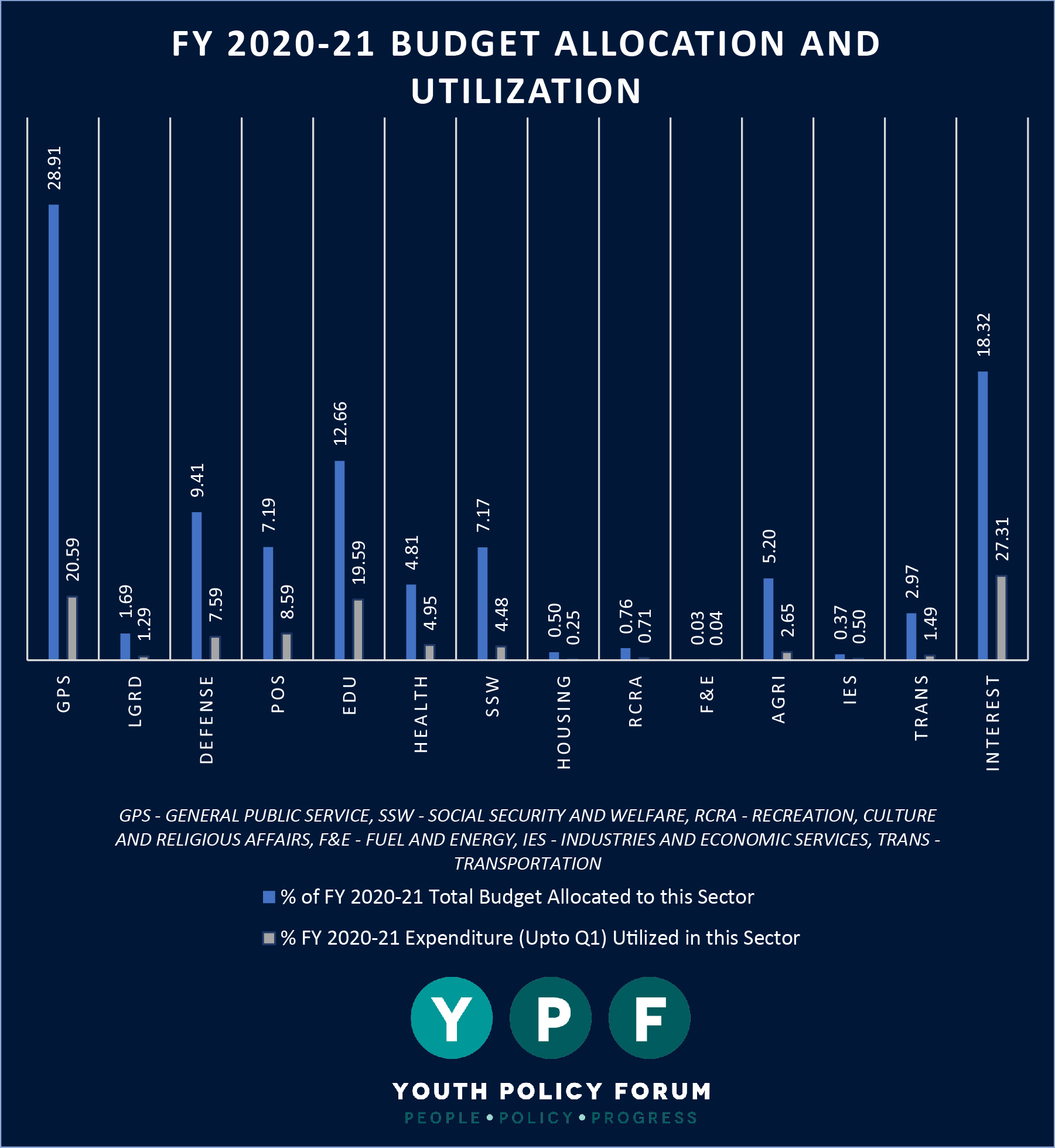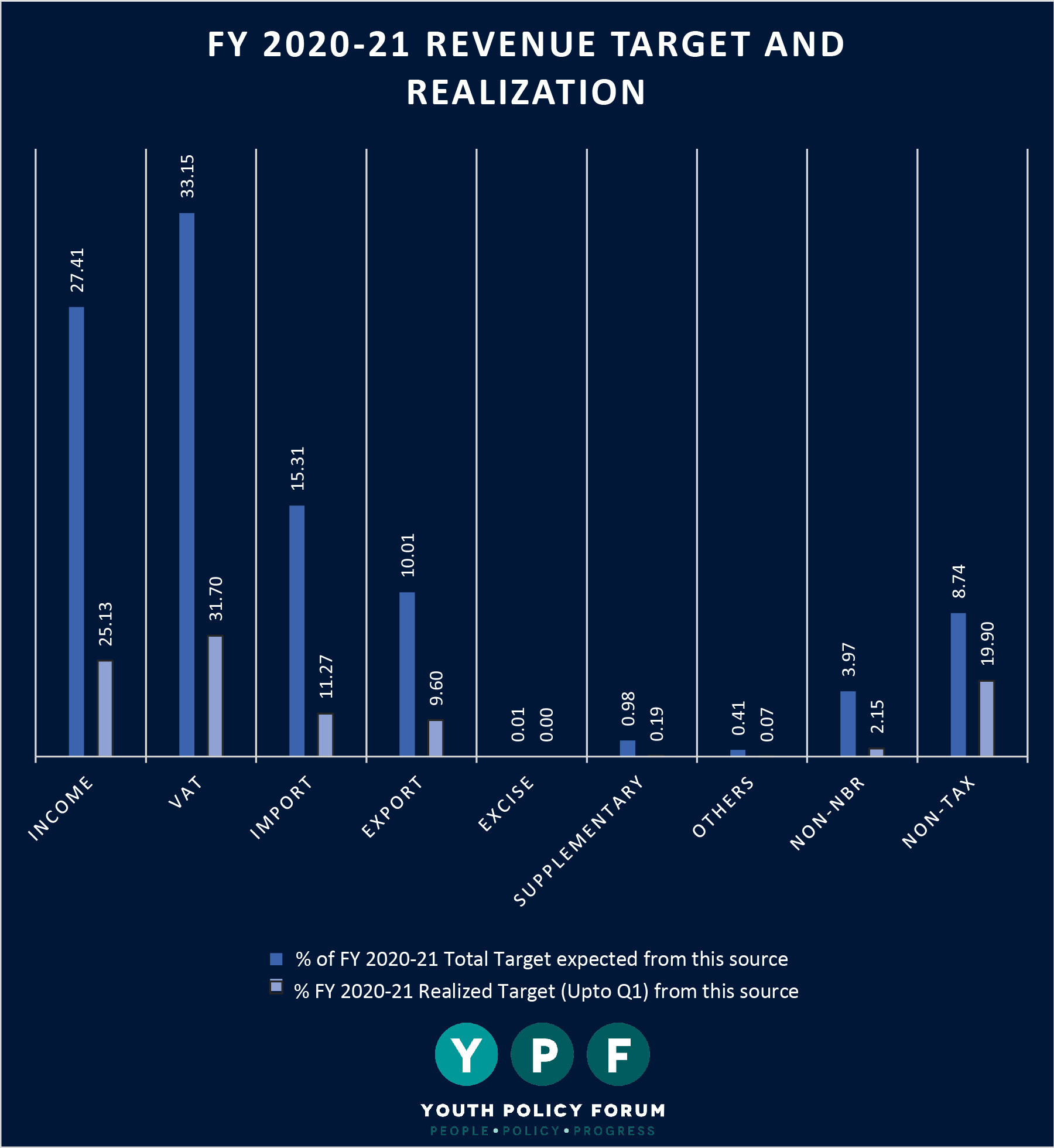Acknowledgment
This brief is prepared by Ahmad Tousif Jami (Research Associate, YPF) and K. M. Najib Hayder (Lead, Grassroots Network, YPF), and vetted by Dr. Mohammad Tarikul Islam, (YPF Senior Fellow, Local Economic Development). For more information, please contact either ahmadtousifjami@ypfbd.org or najibhayder@ypfbd.org.
Study Objectives and Method
This article titled “Examining Bangladesh FY 2020-21 Upto Q1” is designed to measure the progress of budget utilization and revenue actualization during the first quarter. The fiscal year in Bangladesh starts on July 01 of each year. The fiscal year is divided into 04 spans, each called a quarter. The first quarter of the fiscal year is until October of any respective fiscal year. The data used in this paper is collected directly from official fiscal reports of the Ministry of Finance, the People’s Republic of Bangladesh. The data are sorted separately on budget utilization and revenue realization. Specific trends and insights were realized from the data sets when organized in a graph.
Major Findings
The percentages in the graph show the percentage of total allocation allocated to a sector and the percentage of total utilization during the first quarter in that sector. To elaborate, the general public sector has been allocated 28.91% of the total budget for FY 2020-21, where during the first quarter, only 20.59% of the total utilization has happened in the sector. In a hypothetically ideal world, the utilization would be 28.91% of the total utilization during the first quarter, which is impossible because all sectors cannot maintain the same expenditure ratio. However, this gives us an overview or leads us to an interpretation that enables us to analyze if any sector has been focused more, which it cannot utilize or if any sector requires more attention than given in the budget.
Such interpretation also leads us to an understanding of the efficient sectors. Last year during our budget dialogue, we were vocal about the budget and time overrun in the development budget. Analyzing the utilization of budget throughout all four quarters might explain time overrun or a specific pattern in the relation between time and utilization. The official monthly report of October 2020 has many critical findings in our review. They are organized and reviewed in two separate compartments below.
1. Budget Allocation and Utilization:

- The utilization of the allocated budget in the first quarter is a bit sluggish. Here we can see, the interest payment and education sector together account for 46.9% of the total utilization, where all the other sectors together account for the rest. This might be an indicator that there exists a certain reluctance in utilizing the budget in the initial quarter. However, to be sure of any reluctance that is specific to the first quarter, we need to analyze the other quarters’ performance to check if there is any gradual increase in utilization. Simultaneously, the COVID-19 pandemic might have some impact on the utilization of resources this year.
- On the other hand, the impressive utilization of budget in education and interest payment could indicate that we need to pay more attention to these sectors. The education budget is quite low for a long time, which has increased a bit recently, and the education sector still requires more budget.
- Most lagging are the social security and transportation sectors. Travel restrictions may explain the reason for the transportation sector lagging. In the later part of the FY 2020-21, the Ashrayan project has started to be realized, which requires concentration of budget in the later part. This might as well explain why social security expenditure lagged in the first quarter.
2. Revenue Target and Realization:

- Additional tax and non-NBR revenues are not up to the expectation by the end of the first quarter, whereas the amount of non-tax revenue is awe-inspiring. It is more than half of the total target three quarters remaining.
- Within the NBR revenues, import tax is a bit sluggish, which might be since COVID-19 has a considerable impact on imports.
- Other than import, all other NBR revenues are nearly realized, accepting that realization of revenue in all sectors cannot happen exactly according to the ratio as targeted.
Implementation Challenges and Way forward
Nevertheless, considering the lockdown’s long-lasting impact on businesses as it happened throughout the world, such realization of revenue is not as bad, rather somewhat impressive. After so many years of arranging the Income Tax Fair regularly, NBR has announced that the fair will not take place to avoid public gatherings this year. Considering this, the revenue realization rate should continue, and non-NBR and additional revenues should increase in -the other three quarters. Simultaneously, transportation, agriculture, etc. should utilize their respective budgets in the next three quarters, while in the future, interest payments might become a considerable burden on the economy to bear with upcoming budgets.